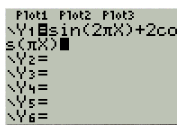
Find the period of the sum of these functions is the least common factor of their individual periods
Answer to Problem 14CT
The period of the sum of these functions is the least common factor of their individual periods which is 2
Explanation of Solution
Given:
Consider the function:
Enter this equation into the graphing calculator as

Press
since, the sine and cosine functions are periodic; their sum will also be periodic.
The period of the function
And, the period of the function
The period of the sum of these functions is the least common factor of their individual periods which is 2. Hence, the period of the function is
Chapter 4 Solutions
EBK PRECALCULUS W/LIMITS
- 4 Consider f(x) periodic function with period 2, coinciding with (x) = -x on the interval [,0) and being the null function on the interval [0,7). The Fourier series of f: (A) does not converge in quadratic norm to f(x) on [−π,π] (B) is pointwise convergent to f(x) for every x = R П (C) is in the form - 4 ∞ +Σ ak cos(kx) + bk sin(kx), ak ‡0, bk ‡0 k=1 (D) is in the form ak cos(kx) + bk sin(kx), ak 0, bk 0 k=1arrow_forwardSolve the equation.arrow_forwardcould you explain this pleasearrow_forward
- the answer is C, could you show me how to do itarrow_forward7. [-/1 Points] DETAILS MY NOTES SESSCALCET2 6.1.505.XP. Evaluate the integral. (Use C for the constant of integration.) 21z³e² dz | 21 Need Help? Read It SUBMIT ANSWER 8. [-/1 Points] DETAILS MY NOTES SESSCALCET2 6.1.020. Evaluate the integral. 36 In y dy ₤36 25 Need Help? Read It SUBMIT ANSWER 9. [-/1 Points] DETAILS MY NOTES SESSCALCET2 6.1.009. Evaluate the integral. (Use C for the constant of integration.) In(7x In(7x + 1) dxarrow_forward10. [-/1 Points] DETAILS MY NOTES SESSCALCET2 6.1.506.XP. Evaluate the integral. √xy dy Need Help? Read It Watch It SUBMIT ANSWER 11. [-/1 Points] DETAILS MY NOTES SESSCALCET2 6.1.023. Evaluate the integral. 1/2 7 cos-1 x dx Need Help? Read It Watch It SUBMIT ANSWER 12. [-/1 Points] DETAILS MY NOTES SESSCALCET2 6.1.507.XP. Evaluate the integral. L² 0 (In x)² x3 dx Need Help? Read Itarrow_forward
- i attached the question and the way i solved it, i believe i made an error, could you point it out for me because the correct answer is 3pi/2correct answer is D, please see both attached photosarrow_forwardQuestion 3 and 4arrow_forwardcould you explain this using stoke theoremi already circled the correct answerarrow_forward
 Calculus: Early TranscendentalsCalculusISBN:9781285741550Author:James StewartPublisher:Cengage Learning
Calculus: Early TranscendentalsCalculusISBN:9781285741550Author:James StewartPublisher:Cengage Learning Thomas' Calculus (14th Edition)CalculusISBN:9780134438986Author:Joel R. Hass, Christopher E. Heil, Maurice D. WeirPublisher:PEARSON
Thomas' Calculus (14th Edition)CalculusISBN:9780134438986Author:Joel R. Hass, Christopher E. Heil, Maurice D. WeirPublisher:PEARSON Calculus: Early Transcendentals (3rd Edition)CalculusISBN:9780134763644Author:William L. Briggs, Lyle Cochran, Bernard Gillett, Eric SchulzPublisher:PEARSON
Calculus: Early Transcendentals (3rd Edition)CalculusISBN:9780134763644Author:William L. Briggs, Lyle Cochran, Bernard Gillett, Eric SchulzPublisher:PEARSON Calculus: Early TranscendentalsCalculusISBN:9781319050740Author:Jon Rogawski, Colin Adams, Robert FranzosaPublisher:W. H. Freeman
Calculus: Early TranscendentalsCalculusISBN:9781319050740Author:Jon Rogawski, Colin Adams, Robert FranzosaPublisher:W. H. Freeman
 Calculus: Early Transcendental FunctionsCalculusISBN:9781337552516Author:Ron Larson, Bruce H. EdwardsPublisher:Cengage Learning
Calculus: Early Transcendental FunctionsCalculusISBN:9781337552516Author:Ron Larson, Bruce H. EdwardsPublisher:Cengage Learning





